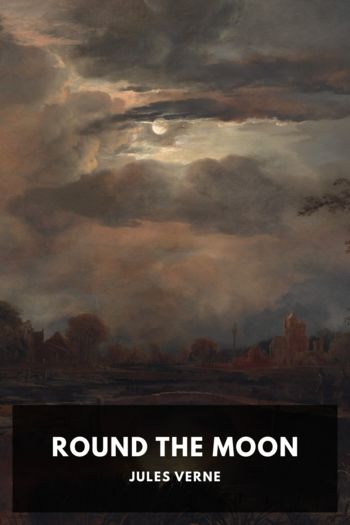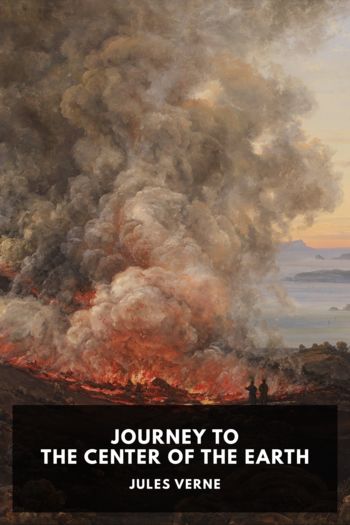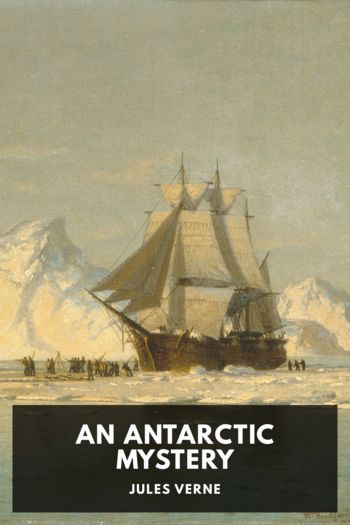Round the Moon by Jules Verne (read aloud txt) 📕

- Author: Jules Verne
Book online «Round the Moon by Jules Verne (read aloud txt) 📕». Author Jules Verne
This circle, one of the most remarkable on the disc, is situated in south lat. 58° and east long. 15°. Its height is estimated at 7,091 metres. The travellers at a distance of 200 miles, reduced to two by the telescopes, could admire the arrangement of this vast crater.
“The terrestrial volcanoes,” said Barbicane, “are only molehills compared to the volcanoes of the moon. Measuring the ancient craters formed by the first eruptions of Vesuvius and Etna, they are found to be scarcely 6,000 metres wide. In France the circle of the Cantal measures five miles; at Ceylon the circle of the island is forty miles, and is considered the largest on the globe. What are these diameters compared to that of Clavius, which we are over in this moment?”
“What is its width?” asked Nicholl.
“About seventy miles,” answered Barbicane. “This amphitheatre is certainly the largest on the moon, but many are fifty miles wide!”
“Ah, my friends,” exclaimed Michel Ardan, “can you imagine what this peaceful orb of night was once like? when these craters vomited torrents of lava and stones, with clouds of smoke and sheets of flame? What a prodigious spectacle formerly, and now what a falling off! This moon is now only the meagre case of fireworks, of which the rockets, serpents, suns, and wheels, after going off magnificently, only leave torn pieces of cardboard. Who can tell the cause, reason, or justification of such cataclysms?”
Barbicane did not listen to Michel Ardan. He was contemplating those ramparts of Clavius, formed of wide mountains several leagues thick. At the bottom of its immense cavity lay hundreds of small extinct craters, making the soil like a sieve, and overlooked by a peak more than 15,000 feet high.
The plain around had a desolate aspect. Nothing so arid as these reliefs, nothing so sad as these ruins of mountains, if so they may be called, as those heaps of peaks and mountains encumbering the ground! The satellite seemed to have been blown up in this place.
The projectile still went on, and the chaos was still the same. Circles, craters, and mountains succeeded each other incessantly. No more plains or seas—an interminable Switzerland or Norway. Lastly, in the centre of the creviced region at its culminating point, the most splendid mountain of the lunar disc, the dazzling Tycho, to which posterity still gives the name of the illustrious Danish astronomer.
Whilst observing the full moon in a cloudless sky, there is no one who has not remarked this brilliant point on the southern hemisphere. Michel Ardan, to qualify it, employed all the metaphors his imagination could furnish him with. To him Tycho was an ardent focus of light, a centre of irradiation, a crater vomiting flames! It was the axle of a fiery wheel, a sea-star encircling the disc with its silver tentacles, an immense eye darting fire, a nimbo made for Pluto’s head! It was a star hurled by the hand of the Creator, and fallen upon the lunar surface!
Tycho forms such a luminous concentration that the inhabitants of the earth can see it without a telescope, although they are at a distance of 100,000 leagues. It will, therefore, be readily imagined what its intensity must have been in the eyes of observers placed at fifty leagues only.
Across this pure ether its brilliancy was so unbearable that Barbicane and his friends were obliged to blacken the object-glasses of their telescopes with gas-smoke in order to support it. Then, mute, hardly emitting a few admirative interjections, they looked and contemplated. All their sentiments, all their impressions were concentrated in their eyes, as life, under violent emotion, is concentrated in the heart.
Tycho belongs to the system of radiating mountains, like Aristarchus and Copernicus. But it testified the most completely of all to the terrible volcanic action to which the formation of the moon is due.
Tycho is situated in south lat. 43° and east long. 12°. Its centre is occupied by a crater more than forty miles wide. It affects a slightly elliptical form, and is enclosed by circular ramparts, which on the east and west overlook the exterior plain from a height of 5,000 metres. It is an aggregation of Mont Blancs, placed round a common centre, and crowned with shining rays.
Photography itself could never represent what this incomparable mountain, with all its projections converging to it and its interior excrescences, is really like. In fact, it is during the full moon that Tycho is seen in all its splendour. Then all shadows disappear, the foreshortenings of perspective disappear, and all proofs come out white—an unfortunate circumstance, for this strange region would have been curious to reproduce with photographic exactitude. It is only an agglomeration of holes, craters, circles, a vertiginous network of crests. It will be understood, therefore, that the bubblings of this central eruption have kept their first forms. Crystallised by cooling, they have stereotyped the aspect which the moon formerly presented under the influence of Plutonic forces.
The distance which separated the travellers from the circular summits of Tycho was not so great that the travellers could not survey its principal details. Even upon the embankment which forms the ramparts of Tycho, the mountains hanging to the interior and exterior slopes rose in stories like gigantic terraces. They appeared to be higher by 300 or 400 feet on the west than on the east. No system of terrestrial castrametation could equal these natural fortifications. A town built at the bottom of this circular cavity would have been utterly inaccessible.
Inaccessible and marvellously extended over this ground of picturesque relief! Nature had not left the bottom of this crater flat and empty. It possessed a special orography, a mountain system which made it a world apart. The travellers clearly distinguished the cones, central hills, remarkable movements of the ground, naturally disposed for the reception of masterpieces of Selenite architecture.





Comments (0)